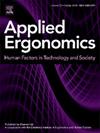VR/AR在人体工程学和工作空间设计中的应用和影响的双重视角分析
IF 3.4
2区 工程技术
Q2 ENGINEERING, INDUSTRIAL
引用次数: 0
摘要
本文献综述系统地研究了虚拟现实(VR)和增强现实(AR)技术在人体工程学和工作空间设计中的应用,使用了来自Web of Science数据库的综合学术文章数据集。结合文献计量学和内容分析的混合评价方法使用HistCite对279篇文章进行了基于引文的分析和性能映射。使用VOSviewer进行文献耦合分析,确定了基于两个不同视角的五个主要研究主题:(1)VR/AR作为改进人体工程学评估和工作空间设计的工具的应用;(2)VR/AR系统使用的人体工程学含义。对48篇高度相关文章的内容分析进一步探讨了这些主题,阐明了对当前趋势、研究差距和未来研究方向的见解。该分析得出的主要结果表明,整合VR/AR可以改善技能获取,减少错误,并提高从临床应用到工业装配线等多个领域的用户参与度。然而,持续存在的障碍包括头戴式耳机的视野有限,触觉保真度不足,由于设备重量和优化不良的用户界面而导致用户疲劳(身体和精神)的风险。主要建议包括优先考虑VR/AR功效的纵向研究,改进认知人体工程学指标,推进触觉反馈系统等。这些见解可以为研究人员和实践者实施沉浸式技术进行物理和认知人体工程学评估提供路线图。本文章由计算机程序翻译,如有差异,请以英文原文为准。
VR/AR in ergonomics and workspace design: a dual-perspective analysis of applications and implications
This literature review systematically examines virtual reality (VR) and augmented reality (AR) technologies in ergonomics and workspace design using a comprehensive dataset of scholarly articles from Web of Science database. A hybrid review methodology integrating both bibliometric and content analysis used HistCite enabled citation-based analysis and performance mapping on 279 articles. Bibliographic coupling analysis using VOSviewer identified five major research themes based on two distinct perspectives: (1) application of VR/AR as tools for improving ergonomic assessments and workspace design, and (2) ergonomic implications of VR/AR system usage. Content analysis of 48 highly relevant articles further explored these themes, elucidating insights into current trends, research gaps, and future research directions. Major outcomes emerged from this analysis demonstrated that integrating VR/AR can improve skill acquisition, reduce errors, and improve user engagement across multiple sectors, from clinical applications to industrial assembly lines. However, persistent barriers include limited field of view in headsets, insufficient haptic fidelity, risk of user fatigue (physical and mental) due to device weight and poorly optimized user interfaces. Key recommendations include prioritizing longitudinal studies on VR/AR efficacy, improving cognitive ergonomics metrics, advancing haptic feedback systems, etc. These insights could provide roadmap for researchers and practitioners implementing immersive technologies for physical and cognitive ergonomic evaluations.
求助全文
通过发布文献求助,成功后即可免费获取论文全文。
去求助
来源期刊

Applied Ergonomics
工程技术-工程:工业
CiteScore
7.50
自引率
9.40%
发文量
248
审稿时长
53 days
期刊介绍:
Applied Ergonomics is aimed at ergonomists and all those interested in applying ergonomics/human factors in the design, planning and management of technical and social systems at work or leisure. Readership is truly international with subscribers in over 50 countries. Professionals for whom Applied Ergonomics is of interest include: ergonomists, designers, industrial engineers, health and safety specialists, systems engineers, design engineers, organizational psychologists, occupational health specialists and human-computer interaction specialists.
 求助内容:
求助内容: 应助结果提醒方式:
应助结果提醒方式:


